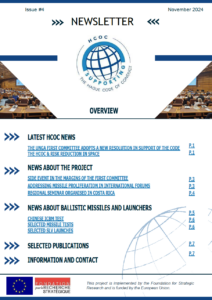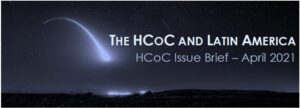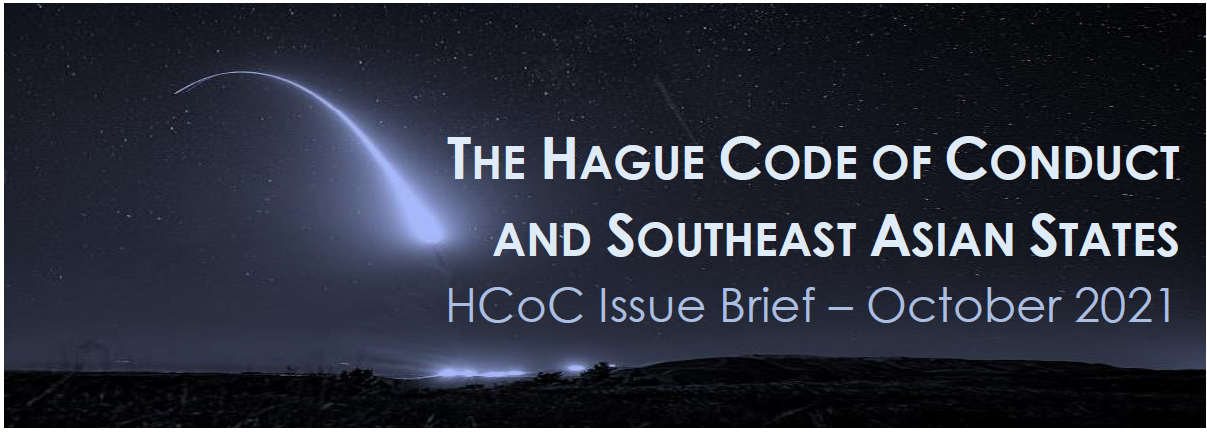
About the Hague Code of Conduct
Adopted in 2002, the Hague Code of Conduct against Ballistic Missile Proliferation (HCoC) is a politically binding instrument aiming to limit the proliferation of weapons of mass destruction (WMD) delivery vehicles. Composed of a set of transparency and confidence-building measures, the HCoC is the only existing multilateral instrument that focuses on WMD delivery vehicles. The HCoC has reached 143 subscribing states (December 2022) vs 93 at its inception.
When subscribing to the HCoC, states commit to abide by a set of UN treaties and international conventions on space security; to produce an annual declaration regarding ballistic missile capacities and national policy on non-proliferation and disarmament treaties and instruments; and to deliver pre-launch notifications prior to any missile or space launch. Documents are uploaded onto a dedicated online platform managed by Austria, which acts as the HCoC Immediate Central Contact (Executive Secretariat). Subscription to the HCoC is free of charge.
While subscribing states are asked to exercise ‘maximum restraint’ in the development of ballistic capacities, they are proscribed neither from possessing ballistic missiles nor from pursuing space launch activities. In return, subscribing to the HCoC enables states to gain access to information shared by other subscribing states, and to display their political commitment to non-proliferation and disarmament.
In brief
Only three out of ten Southeast Asian states have joined the HCoC to date (the Philippines, Cambodia and Singapore). This limited rate is noteworthy as Southeast Asia is increasingly concerned by the ongoing ballistic missile competition in broader Asia. Moreover, the region is actively investing to benefit from space technologies.
Southeast Asian states’ historic preference for addressing non-proliferation and disarmament within multilateral frameworks, alongside a lack of information about the Code, partly explain their reluctance about joining the HCoC.
Ongoing developments however make the HCoC increasingly relevant for Southeast Asian states. By committing to confidence-building measures such as the Code, they can contribute to strengthening regional stability.
Authors: Lauriane Héau and Emmanuelle Maitre
A limited missile activity in Southeast Asia overshadowed by the ongoing missile race in the broader region
Only two states in the region1 are reported as possessing ballistic missiles: Myanmar and Vietnam. Myanmar may have acquired SY-400 systems from China in 2020, while Vietnam is thought to possess short-range Scud-B missiles imported from the USSR and possibly Scud-C missiles imported from North Korea.2
While limited for states from the Association of Southeast Asian Nations (ASEAN), the ballistic missile threat is growing in broader Asia, where the development of ballistic missiles is both a cause of and a reaction to current tensions. Today, China, India, North Korea, Pakistan, South Korea and Taiwan have all deployed short, medium or long-range systems. The regional missile race creates action-reaction cycles which increase military instability. This is visible for instance with the deployment of long-range missiles by Pyongyang, which has led to the installation of missile defence infrastructure by the United States and its allies, which in turn has triggered the modernisation of Chinese offensive weapons.
Increased interest in space technologies
Southeast Asian states are deeply involved in the peaceful use of space and have a crucial stake in space security as they rely on space assets for a number of key economic and social activities. Although there is no operational space launching site yet, Indonesia showed an early interest for the acquisition of rocket technologies as it set up the sounding rocket programme RX in the 1980s. The country is now working on developing a full-fledged small satellite launcher.3
Moreover, nine out of ten ASEAN states are operating satellites and a majority of them are involved in their conception or manufacturing. More states plan to develop these capacities, in particular in the framework of international cooperation schemes.4 These space developments are not yet embedded in a normative framework – as shown by the limited participation of ASEAN states in the Outer Space conventions (Figure 1).
The HCoC brings transparency to the development of dual-use technologies, which can be used for the production of missiles but also civilian launchers. As a result, ongoing developments make the HCoC increasingly relevant for Southeast Asian states – not only given the development of ballistic missile capabilities in the broader Asian region but also as exploiting civilian technologies could lead to rising instability if not coupled with confidence-building measures (CBMs).
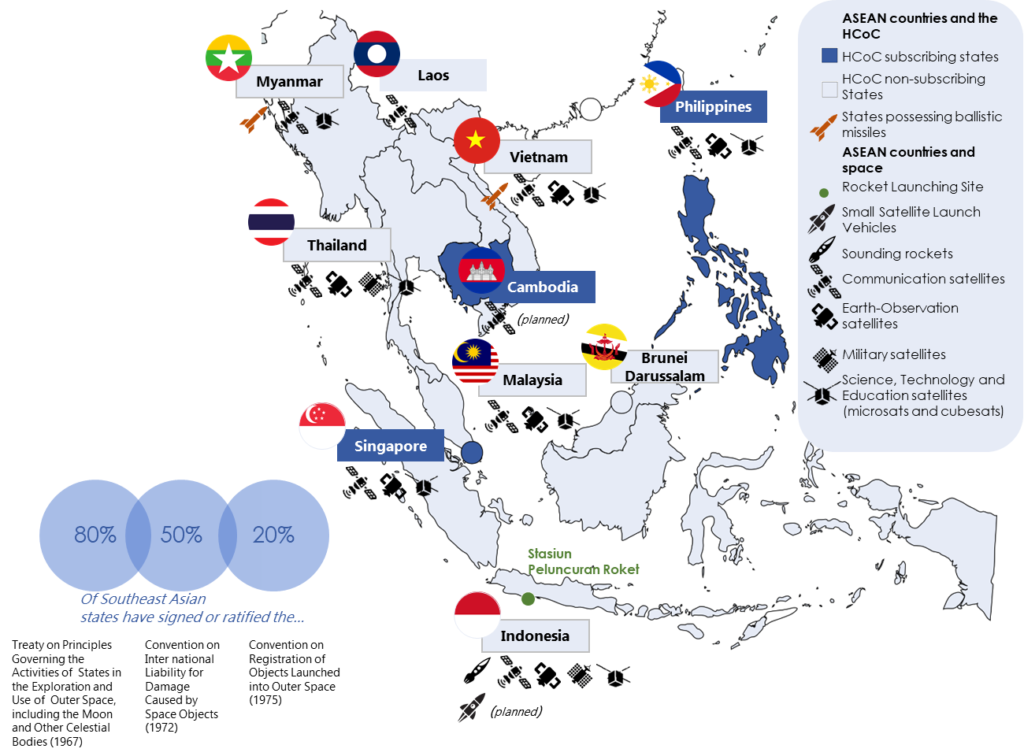
Diverse positions on the HCoC
Three out of the ten ASEAN member states have so far subscribed to the Code. The Philippines is the only state to have subscribed at the HCoC’s inception, and has since played a major role as it assumed the rotating chairmanship of the Code in 2006-2007. Although the majority of ASEAN states are yet to join the Code, their positive voting record for United Nations General Assembly (UNGA) Resolutions in support of the Code shows they are not opposed to its objectives. A majority of ASEAN states has consistently supported these resolutions – with six states having always voted in favour; while Laos, Malaysia and Vietnam overturned their decision over time to start voting in favour (Figure 2). The latest resolution, passed in December 2022, was therefore adopted with a positive vote from eight out of ten states of the region.
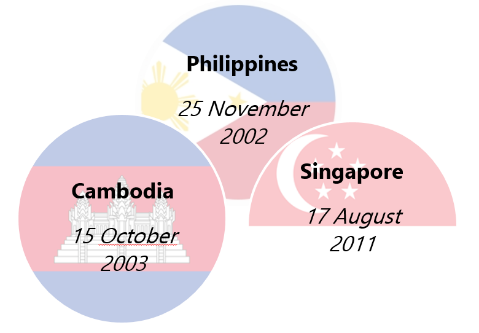
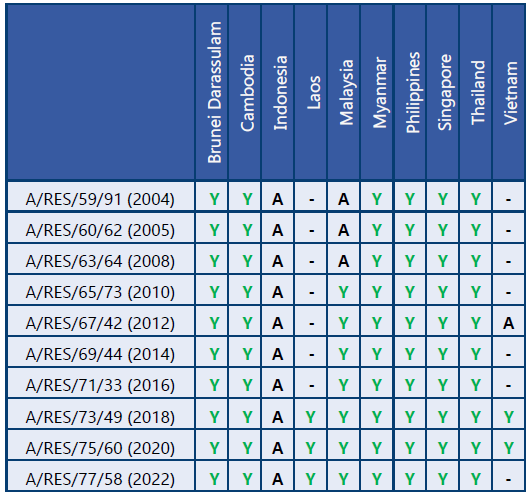
Several factors contribute to explaining why seven ASEAN states remain outside of the HCoC. Institutional challenges do exist, including a lack of information about the Code and a low level of prioritisation of this instrument. Geopolitical considerations may also be influential. Some states may be attentive to the position taken by other key regional players, or might want investigate whether the HCoC aligns with their security interests. The adoption of the Code outside the UN framework is still perceived negatively by some states, although UNGA resolutions have since partly remedied this. Finally, as the HCoC emerged from the MTCR, some states fear that it could aim at limiting the transfer of certain technologies, in particular civilian space launch technologies.
Regional support for WMD disarmament and non-proliferation
The limited participation of ASEAN states to the HCoC may appear paradoxical as they hold a strong record in the field of non-proliferation and disarmament. In 1995, they adopted the Southeast Asian Nuclear Weapon Free-Zone (Bangkok Treaty). They have displayed a strong support for norms such as the Biological Weapons Convention (BWC), the Chemical Weapons Convention (CWC) or the Comprehensive Test Ban Treaty (CTBT).
Regional actors such as Indonesia and Malaysia have traditionally been very active in non-proliferation and disarmament forums and have in particular supported the cause of disarmament within the non-aligned movement. Recently, ASEAN countries played an important role in the adoption of the Treaty on the Prohibition of Nuclear Weapons (TPNW).
This contrast can in part be explained by the historic distrust shown by some Southeast Asian states with regards to export control regimes; and by their preference that non-proliferation issues be considered at the multilateral level, ensuring equal participation for all states and respecting their sovereignty.
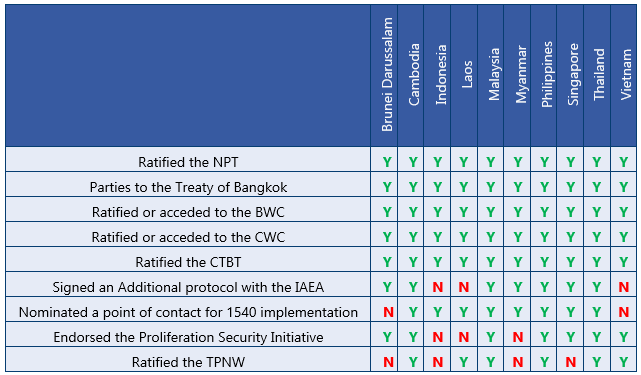
Subscribing to the HCoC: what opportunities for Southeast Asian states?
Despite concerns raised by some ASEAN countries regarding the HCoC, a reassessment of the Code may lead a number of states to gain awareness about the Code’s relevance for their security.
Firstly, the HCoC establishes CBMs with regional and global powers on ballistic missile and space capabilities. It does not hamper their development but creates a framework for such technologies, notably by bringing transparency on space programmes, clarifying the nature of these activities and providing information on launches. Adhering to non-proliferation instruments such as the HCoC may become key in the establishment of international partnerships, as it could constitute a criterion to favour the dissemination of space launching technologies and jointly planning future spaceports. Secondly, proliferation risks involving states and non-state actors remain a feature of the international security landscape, especially for transit and maritime regions such as Southeast Asia.5 As such, regional businesses actively involved in the manufacturing of dual-use items, as well as shipping and trans-shipping companies, can only benefit from a clear non-proliferation stance and updated export control guidelines. Finally, as international tensions build up and major power relations deteriorate, intermediary and pragmatic measures such as the HCoC could be beneficial as they limit the risk of WMD use as long as these weapons exist. Joining the HCoC is therefore a concrete way of showing one’s opposition to the dissemination and deployment of ballistic systems and supporting the universalisation of CBMs in a global environment marked by insecurity.
1 In this Issue Brief, Southeast Asia is defined as ASEAN member states.
2 ‘Vietnam,’ Nuclear Threat Initiative, last updated December 2015, <https://www.nti.org/learn/countries/vietnam/>.
3 ‘Indonesia to build the nation’s first spaceport in Papua,’ The Jakarta Post, 12 November 2019, <https://www.thejakartapost.com/news/2019/11/12/indonesia-to-build-the-nations-first-spaceport-in-papua.html>.
4 Nandini Sarma, ‘Southeast Asian Space Programmes: Capabilities, Challenges and Collaborations’, ORF Special Report, n° 82, March 2019.
5 Nick Gillard, ‘Dual-Use Traders: The Real WMD Threat in Southeast Asia?,’ The Diplomat, 22 January 2015, <https://thediplomat.com/2015/01/dual-use-traders-the-real-wmd-threat-in-southeast-asia/>.

